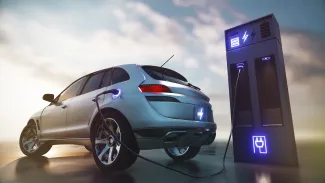
EarthTalk - What’s new regarding more efficient batteries?
©
Dear EarthTalk:
What’s new regarding more efficient batteries that can help usher in a new age of renewable energy?
Paul Beckman, Marion, OH
Batteries are everywhere—in your phone, your car—even the artificial organs that many depend on for life. But behind this universal usage is extensive ecological damage—the battery-making process requires intensive mining for heavy metals, leaks toxins into soil and water, and depletes local water sources in communities. But new and innovative ways to increase the efficiency and sustainability of batteries.

One of the most novel innovations out this year is iron-air batteries, those that use a sustainable rust-based reaction to produce energy. As air passes through the cathode (the negatively-charged portion of the battery) and reacts with the liquid, a water-based electrolyte, ions subsequently latch onto the positively-charged iron anode, producing rust. The movement of ions through this rust produces electricity, a process that can be repeated by continually unrusting the battery after each reaction. Form energy co-founder and Chief Scientist Yet-Ming Chiang notes the economic viability of iron-air batteries for large-scale usage: “Air is still free and iron is one of the most widely produced, lowest cost materials in the world.” In Minnesota, a 1.5 megawatt pilot project was shown to be able to power 400 homes for 100 hours, a clear example of how iron-air batteries could be the next big innovation for large-scale battery usage.
Besides iron-air batteries, solid-state batteries are what George Crabtree, director of the Joint Center for Energy Storage Research, believes to be “very likely... the next big thing at the commercial level.” Solid-state batteries use electrolytes like argyrodite, garnet and perovskite that are more efficient than liquid-electrolytes in nearly all aspects: they’re lighter, take up less space and can hold more energy per unit of mass. These qualities make them effective for Electrical Vehicle (EV) usage and grid-scale energy storage. However, researchers like University of Houston professor Yan Yao, who recently developed a glass-like electrolyte, are still looking for materials that fulfill all four factors for viability in the market: low-cost, easy-to-build, having a high degree of mechanical stability, and chemical stability.
With lithium-based batteries being so ubiquitous, some scientists are looking to improve on the existing model rather than supplanting it entirely. Batteries made out of Lithium-Sulfur, for example, exhibit four times greater energy density than traditional lithium batteries due to their usage of light, active materials. Ultimately, innovations in batteries are a cornerstone to shaping a more sustainable future. According to associate professor of materials science at Columbia University Yuan Yuang, making renewable energy more reliable will help stabilize energy grids and support a more sustainable energy future.
CONTACTS
- Three battery technologies that could power the future, https://saft.com/en/media-resources/our-stories/three-battery-technologies-could-power-future.
EarthTalk® is produced by Roddy Scheer & Doug Moss for the 501(c)3 nonprofit EarthTalk. See more athttps://emagazine.com. To donate, visit https://earthtalk.org. Send questions to: question@earthtalk.org.

















